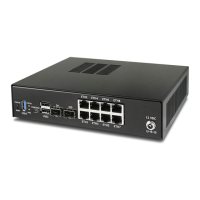Product ManualXG-7100
FreeBSD
The device associated with the system console is likely to show up as /dev/cuaU1. Look for messages about the device
attaching in the system log files or by running dmesg.
4.2.4 Launch a Terminal Program
Use a terminal program to connect to the system console port. PuTTY is a popular terminal program that is available
on various operating systems. Some other choices of terminal programs:
• Linux: screen, PuTTY, minicom, dterm
• Mac OS X: screen, ZTerm, cu
• Windows: PuTTY, SecureCRT, Do not use Hyperterminal
• FreeBSD: screen, cu
The settings to use within the terminal program are:
Speed 115200 baud
Data bits 8
Parity none
Stop bits 1
Flow Control Off or XON/OFF. Hardware flow control (RTS/CTS) must be disabled.
Client-Specific Examples
PuTTY
Launch PuTTY and configure it for a Serial type connection with a speed of 115200 using the port name located
previously.
• Windows Example:
• Linux Example:
PuTTY generally handles most cases OK but can have issues with line drawing characters on certain platforms.
These settings seem to work best (tested on Windows):
4.2. Advanced Configuration 39

